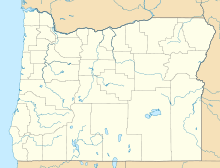- Neahkahnie Mountain
-
Neahkahnie Mountain
Neahkahnie Mountain from the North.Elevation 1680+ feet (512+ m) [1] Translation The place of the supreme deity [2] (Tillamook) Location Tillamook County, Oregon, USA Range Northern Oregon Coast Range Coordinates 45°44′49″N 123°57′06″W / 45.74696°N 123.951783°WCoordinates: 45°44′49″N 123°57′06″W / 45.74696°N 123.951783°W[1] Topo map USGS Nehalem Neahkahnie Mountain is a mountain on the Oregon Coast, north of Manzanita in Oswald West State Park overlooking U.S. Route 101. The peak is part of the Northern Oregon Coast Range, which is part of the Oregon Coast Range.[1] Neah-Kah-Nie in the Tillamook language can be translated as "the place of the supreme deity."[2]
History
 View of Manzanita and Nehalem Bay from Neahkanie Mountain
View of Manzanita and Nehalem Bay from Neahkanie Mountain
The challenge faced by Elbridge Trask of crossing Neahkahnie Mountain into the Tillamook valley is part of the plot of Don Berry's novel Trask.
A legend, dating back to the mid-1800s and the first Hudson's Bay Co. employees to arrive in the area, claims the mountain conceals a lost treasure, hidden by Spanish sailors in the late 16th century.[3] There are various versions of the legend, but the most common ones involve a group of sailors carrying a chest up the hillside, then digging a hole and lowering the treasure inside. As the story goes, one of the sailors then plunges his sword into one of the men with them, apparently an African slave, and his body was then thrown in on top of the treasure; the idea being, Native Americans would not disturb a man's grave, so keeping the treasure under a dead man would prevent the Native Americans—who, in most versions of the story were watching the activity closely from nearby—from digging it up.[4]
The "lost treasure," subject of the 2006 movie Tillamook Treasure, has been searched for by hundreds of people over the years, some resorting to earth-moving equipment and others digging by hand. During the 1930s, two treasure hunters died when their excavation caved in on them.
Digging for treasure is prohibited on the portions of the mountain that are in the control of the Oregon Parks Service and is also prohibited on the beach, also part of the Oregon State parks. Some artifacts of possibly Spanish origin have been found on the mountain; notably, in the 1870s, a collection of stones with arrows marked on them and one with the letters D E W on it found by treasure hunter Pat Smith.[3] But no treasure or evidence of treasure is known to have been found.[5]
Spanish ships might have come to the area by the 16th century. Ships using the Manila galleon trade route usually made landfall on the southern California coast, but it is possible some made landfall as far north as Oregon. The 1543 voyage of Juan Rodríguez Cabrillo reached California and, under Bartolomé Ferrelo, might have reached the Oregon coast.[6] The 1774 voyage of Juan Pérez was the first European voyage to have unquestionably reached the Oregon coast.[7]
References
- ^ a b c "Neahkahnie Mountain, Oregon". Peakbagger.com. http://www.peakbagger.com/peak.aspx?pid=18390. Retrieved 2009-12-31.
- ^ a b "Neah-Kah-Nie Mountain". Neahkahnie.net. http://www.neahkahnie.net/neahkahnie.htm. Retrieved 2009-12-31.
- ^ a b "The legendary Spanish gold of Neahkahnie Mountain". OffbeatOregonHistory.com. http://www.offbeatoregon.com/H1008d_spanish-gold-of-neahkahnie-mountain.html. Retrieved 2011-07-05.
- ^ Sullivan, William. _Hiking Oregon's History_. Eugene, Ore.: Navillus Press, 2006.
- ^ "Hidden Treasures of Neahkahnie Mountain". Neahkahnie.net. http://www.neahkahnie.net/neahkahnietreasure.htm. Retrieved 2008-04-31.
- ^ "Juan Rodríguez Cabrillo — A Voyage of Discovery". National Park Service. http://www.nps.gov/archive/cabr/juan.html. Retrieved 2009-12-31.
- ^ Sanchez, Antonio. "Spanish Exploration: Juan Perez Expedition of 1774 — First European Discovery and Exploration of Washington State Coast and Nueva Galicia (the Pacific Northwest)". HistoryLink.org. http://www.historylink.org/index.cfm?DisplayPage=output.cfm&File_Id=5677. Retrieved 2009-12-31.
External links
- "Neahkahnie Mountain". Geographic Names Information System, U.S. Geological Survey. http://geonames.usgs.gov/pls/gnispublic/f?p=gnispq:3:::NO::P3_FID:1124612. Retrieved 2008-12-31.
Oregon Coast Range Northern - Five highest peaks: Rogers Peak
- South Saddle Mountain
- Larch Mountain
- Trask Mountain
- Saddle Mountain
Central - Five highest peaks: Marys Peak
- Grass Mountain
- Laurel Mountain
- Prairie Peak
- Saddle Bag Mountain
Southern - Four highest peaks: Bone Mountain
- Kenyon Mountain
- Bear Mountain
- Buzzard Rock
See also Categories:- Mountains of Oregon Coast Range
- Landforms of Tillamook County, Oregon
Wikimedia Foundation. 2010.


